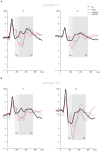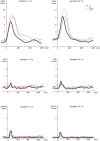Increased Event-Related Potentials and Alpha-, Beta-, and Gamma-Activity Associated with Intentional Actions
- PMID: 26834680
- PMCID: PMC4722116
- DOI: 10.3389/fpsyg.2016.00007
Increased Event-Related Potentials and Alpha-, Beta-, and Gamma-Activity Associated with Intentional Actions
Abstract
Objective: Internally guided actions are defined as being purposeful, self-generated and offering choices between alternatives. Intentional actions are essential to reach individual goals. In previous empirical studies, internally guided actions were predominantly related to functional responses in frontal and parietal areas. The aim of the present study was to distinguish event-related potentials and oscillatory responses of intentional actions and externally guided actions. In addition, we compared neurobiological findings of the decision which action to perform with those referring to the decision whether or not to perform an action.
Methods: Twenty-eight subjects participated in adapted go/nogo paradigms, including a voluntary selection condition allowing participants to (1) freely decide whether to press the response button or (2) to decide whether they wanted to press the response button with the right index finger or the left index finger.
Results: The reaction times were increased when participants freely decided whether and how they wanted to respond compared to the go condition. Intentional processes were associated with a fronto-centrally located N2 and P3 potential. N2 and P3 amplitudes were increased during intentional actions compared to instructed responses (go). In addition, increased activity in the alpha-, beta- and gamma-frequency range was shown during voluntary behavior rather than during externally guided responses.
Conclusion: These results may indicate that an additional cognitive process is needed for intentional actions compared to instructed behavior. However, the neural responses were comparatively independent of the kind of decision that was made (1) decision which action to perform; (2) decision whether or not to perform an action).
Significance: The study demonstrates the importance of fronto-central alpha-, beta-, and gamma oscillations for voluntary behavior.
Keywords: EEG; event-related potentials; intentional action; oscillatory activity; voluntary selection.
Figures




Similar articles
-
"Free won't" of food in overweight and normal-weight adults: Comparison of neurocognitive correlates of intentional and reactive inhibitions.Neuropsychologia. 2022 Sep 9;174:108351. doi: 10.1016/j.neuropsychologia.2022.108351. Epub 2022 Aug 20. Neuropsychologia. 2022. PMID: 35995241
-
Action Choice and Outcome Congruency Independently Affect Intentional Binding and Feeling of Control Judgments.Front Hum Neurosci. 2018 Apr 11;12:137. doi: 10.3389/fnhum.2018.00137. eCollection 2018. Front Hum Neurosci. 2018. PMID: 29695958 Free PMC article.
-
Neural and behavioral correlates of intentional actions.Neuropsychologia. 2011 Apr;49(5):767-776. doi: 10.1016/j.neuropsychologia.2011.01.025. Epub 2011 Jan 19. Neuropsychologia. 2011. PMID: 21255591 Review.
-
EEG activations during intentional inhibition of voluntary action: an electrophysiological correlate of self-control?Neuropsychologia. 2010 Jan;48(2):619-26. doi: 10.1016/j.neuropsychologia.2009.10.026. Epub 2009 Oct 31. Neuropsychologia. 2010. PMID: 19883667
-
Response priming in the Go/NoGo task: the N2 reflects neither inhibition nor conflict.Clin Neurophysiol. 2007 Feb;118(2):343-55. doi: 10.1016/j.clinph.2006.09.027. Epub 2006 Nov 30. Clin Neurophysiol. 2007. PMID: 17140848
Cited by
-
Separability of motor imagery of the self from interpretation of motor intentions of others at the single trial level: an EEG study.J Neuroeng Rehabil. 2017 Jun 26;14(1):63. doi: 10.1186/s12984-017-0276-4. J Neuroeng Rehabil. 2017. PMID: 28651628 Free PMC article.
-
Predictive acoustical processing in human cortical layers.bioRxiv [Preprint]. 2025 Jan 9:2025.01.09.632099. doi: 10.1101/2025.01.09.632099. bioRxiv. 2025. PMID: 39829870 Free PMC article. Preprint.
-
Hyperactivity of Rac1-GTPase pathway impairs neuritogenesis of cortical neurons by altering actin dynamics.Sci Rep. 2018 May 8;8(1):7254. doi: 10.1038/s41598-018-25354-3. Sci Rep. 2018. PMID: 29740022 Free PMC article.
-
Hybrid framework of fatigue: connecting motivational control and computational moderators to gamma oscillations.Front Neuroergon. 2024 May 28;5:1375913. doi: 10.3389/fnrgo.2024.1375913. eCollection 2024. Front Neuroergon. 2024. PMID: 38864094 Free PMC article.
-
Machine learning models effectively distinguish attention-deficit/hyperactivity disorder using event-related potentials.Cogn Neurodyn. 2022 Dec;16(6):1335-1349. doi: 10.1007/s11571-021-09746-2. Epub 2022 Feb 15. Cogn Neurodyn. 2022. PMID: 36408064 Free PMC article.
References
-
- Basar E. (1998). Brain Function and Oscillations I. Brain Oscillations: Principles and Approaches. Heidelberg: Springer.
-
- Basar E. (1999). Brain Functiona nd Oscillations II. Integrative Brain Function. Neurophysiology and Cognitive Processes. Heidelberg: Springer.
LinkOut - more resources
Full Text Sources
Other Literature Sources

